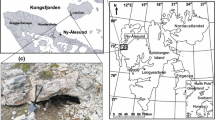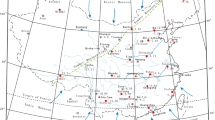Abstract
A peat core with depths of 297 cm was obtained from the Dajiuhu Basin (31°29′27″N, 109°59′45″E, 1760 m) in Hubei Province, Central China. 10 AMS ages provide a time control and reveal that this core spans the past about 16.0 kaBP (calibrated age) (14C age: 13.3 kaBP). Multi-proxy indexes analysis of geochemistry shows the following character of climate and environmental changes since about 16 kaBP: (1) The climate during the late-glacial period was cold and wet as a whole, but fluctuated continually. 11.4–12.6 cal. kaBP, 12.6–15.2 cal. kaBP and 15.2–16 kaBP were corresponding respectively to the Younger Drays, Bølling-Allerød Warm Period and the Oldest Drays. (2) Inheriting the some climate characteristics of the late-glacial, the climate during the early-Holocene was wet and temperature increased gradually, during which an obvious dry event around 10.6 cal. kaB appeared. (3) The climate during the mid-Holocene was genarally warm and wet.During 9.2–7.5 kaBP, temperature increased gradually, precipitation was less comparatively and the 8.2 kaBP cold event which might be representative in the globe was reflected markedly. Then, multi-proxy records were relatively stable during 6.7–4.2 kaBP, which shows the best water and thermal condition in the Holocene Optimum. (4) Around 4.2 kaBP, the climate and environment transform from warm and wet to cool and dry, which may result in the collapse of the Neolithic Culture and midwifery the civilization of Xia Dynasty in this region. After 0.9 kaBP, the climate turned cool and wet. Climate and environmental changes archived in Dajiuhu peat respond to the global changes since the late-glacial period and can be contrasted to the changes recorded in other high-resolution archives from the East Asia Monsoon region, which take on the variety model that the monsoon strengthened abruptly after the late-glacial, was strong during the early Holocene, subsequently declined and became weak after the middle Holocene with dry climate. According to our analysis, the driving mechanism should be the response of solar radiation changes in the East Asia Monsoon region at middle latitudes.
Similar content being viewed by others
References
Alley R B, Marotzke J, Nordhaus W D, et al. Abrupt climate change. Science, 2003, 299: 200–209
Chai X. Peat Geoscience (in Chinese). Beijing: Geological Publishing House, 1990. 1–4
Frank M C, Dan J C, Holocene environmental change: contributions from the peatland archive. The Holocene, 2004, 14(1): 1–6
Meng X X. Swamp Records of China (in Chinese). Beijing: Science Press, 1999. 408–409
Yin S C. Peat Resources and Utilization of China (in Chinese). Beijing: Geological Publishing House, 1991. 70–124
Li W Y, Liu G, Zhou M M. Vegetation and climate during the Holocene Megathermal in Western Hubei Province. In: Shi Y F, Kong Z C, eds. Climate and Environment During the Holocene Megathermal (in Chinese). Beijing: Ocean Press, 1992. 94–99
Li W Y. Vegetation and Environment During the Quaternary in China (in Chinese). Beijing: Science Press, 1998. 133–141
Liu H P, Tang X C, Sun D H. Palynofloras of the Dajiuhu Basin in Shennongjia Mountains during the last 12.5 ka. Acta Micropalaeontol Sin (in Chinese), 2001, 18(1): 101–109
He B Y, Zhang S, Cai S M. Climatic changes recorded in peat from the Dajiu Lake Basin in Shennongjia since the last 2600 years. Mar Geol Quat Geol (in Chinese), 2003, 23(2): 109–115
Zhu C, Ma C M, Zhang W Q, et al. Pollen record and environmental changes from Dajiuhu Basin of Shennongjia since 15.753 kaBP. Quat Sci (in Chinese), 2006, 26(5): 814–826
Zhou W J, Lu X F, Wu Z K, et al. Peat record reflecting Holocene climatic change in the zoigê Plateau and AMS radiocarbon dating. Chin Sci Bull, 2002, 47(1): 66–70
Stuiver M, Reimer P J, Bard E, et al. INTCAL98 Radiocarbon age calibration 24000–0 cal BP. Radiocarbon, 1998, 40: 1041–1083
Dean W E. Determination of carbonate and organic matter in calcareous sediments and sedimentary rocks by loss of ignition: Comparison with other methods. J Sediment Petrol. 1974, 44: 242–248
Li X Q, Zhou W J, An Z S, et al. The vegetation and mosoon variations at the desert-loess transition belt at Midiwan in northern China for the last 13 ka. The Holocene, 2003, 13(5): 779–784
Zhou W J, Yu X F, Jull A J, et al. High-resolution evidence from southern China of an early Holocene optimum and a mid-Holocene dry event during the past 18000 years. Quat Res, 2004, 62(1): 39–48
Hong Y T, Hong B, Lin Q H, et al. Inverse phase oscillations between the East Asian and Indian Ocean summer monsoons during the last 12000 years and paleo-El Niño. Earth Planet Sci Lett, 2005, 231: 337–346
Wang Y J, Cheng H, Edwards R L, et al. A high-resolution absolute-dated Late-Pleistocene monsoon recorded from from Hulu Cave, China. Science, 2001, 294: 740–743
Wang Y J, Cheng H, Edwards R L, et al. The Holocene Asian monsoon: link to solar changes and north Atlantic climate. Science, 2005, 308: 854–857
Dykoski C A, et al. A high-resolution, absolute-dated Holocene and deglacial Asianmonsoon record from Dongge Cave, China. Earth Planet Sci Lett, 2005, 233: 71–86
Gergana Y, Norbert R, Jens M, et al. Influence of the intertropical convergence zone on the East Asian monsoon. Nature, 2007, 445: 74–77
Shao X H, Wang Y J, Cheng H, et al. Stalagmite record of monsoon climate changes and arid events from Shennongjia of Hubei Province. Chin Sci Bull, 2006, 51(1): 80–86
North Greenland Ice Core Project Members. High-resolution record of Northern Hemisphere climate extending into the last interglacial period. Nature, 2004, 431: 147–151
Yao T D, Thompson L G, Shi Y T, et al. Climate changes recorded in Guliya ice-core since the last inter-glacial. Sci China Ser D (in Chinese), 1997, 27(5): 447–452
Wang P X, Bian Y H, Li B H, et al. The “Younger Drays” event in marginal sea of the west Pacific. Sci China Ser D (in Chinese), 1996, 26(5): 452–460
Wang S Y, Lü H Y, Liu J Q, et al. The early Holocene optimum inferred from a high-resolution pollen record of Huguangyan Maar Lake in southern China. Chin Sci Bull, 2007, 52(20): 2829–2836
Zhu C, Zheng C G, Ma C M. et al. On the Holocene sea-level high-stand along the Yangtze Delta and Ningshao Plain, East China. Chin Sci Bull, 2003, 48(24): 2672–2683
Zhu K Z. Pilot study to climate transition since nearly 5000 years in China. Acta Archaeol Sin (in Chinese), 1972, (1): 15–38
Shi Y F, Kong Z C, Wang S M, et al. Climate fluctuation and important events during the Holocene Megathermal. Sci China Ser B (in Chinese) 1992, 22(12): 1300–1308
An Z S, Stephen C P, John E K, et al. Asynchronous Holocene optimum of the East Asian monsoon. Quat Sci Rev, 2000, 19: 743–762
Shen J, Liu X Q, Matsumoto R, et al. Multi-proxy and high-resolution paleoclimate record from the sediment of Qinghai Lake since lateglacial. Sci China Ser D-Earth Sci, 2004, 34(6): 582–589
Liu X Q, Shen J, Wang S M, et al. A 16000-year pollen record of Qinghai Lake and its paleoclimate and paleoenvironment. Chin Sci Bull, 2002, 47(22): 1931–1936
Jin G Y, Liu D S. Mid-Holocene climate change in North China, and the effect on cultural development. Chin Sci Bull, 2002, 47(5): 408–413
Wu W X, Liu T S. Possible role of the “Holocene Event 3’ on the collapse of Neolithic Cultures around the Central Plain of China. Quat Int, 2004, 117: 153–166
Yi S, Saito Y, Oshima H, et al. Holocene environmental history inferred from pollen assemblages in the Huanghe (Yellow River) delta, China: climatic change and human impact. Quat Sci Rev, 2003, 22(5–7): 609–628
Zhu C, Yu S Y, Lu C C. The study of Holocene environmental archaeology and extreme flood disaster in the Three Gorges of the Changjiang River and the Jianghan Plain. Acta Geogr Sin (in Chinese), 1997, 52: 268–277
Chen F H, Huang X Z, Yang M L, et al. Westerly dominated Holocene climate model in arid central Asia—Case study on Bosteng Lake, Xinjiang. Quat Sci (in Chinese), 2006, 26(6): 881–887
Zhu C, Zhong Y S, Zheng C G, et al. Relationship of archaeological sites distribution and environment from the Paleolithic Age to the Warring States in Hubei Province. Acta Geogr Sin (in Chinese), 2007, 62(3): 227–242
Zhu C, Environmental archaeology problems since the Neolithic age in the Yangtze River valley. Prog Nat Sci (in Chinese), 2005, 15(2): 149–153
Zhang Y, Zhu C. Study on cultural faults of the archaeological sites in the Three Gorges of Yangtze River. Acta Geog Sin (in Chinese), 2007, 62(3): 243–256
Zhu C, Ma C M, Wang H L, et al. Characteristics of paleoflood deposits archived in unit T0403 of Yuxi Site, the Three Gorges reservoir areas, China. Sci China Ser D-Earth Sci, 2008, (Suppl. I): 1–17
Zhu C, Zheng C G, Ma C M, et al. Identifying paleoflood deposits archived in Zhongba Site, the Three Gorges reservoir region of the Yangtze River, China. Chin Sci Bull, 2005, 50(21): 2493–2504
Author information
Authors and Affiliations
Corresponding author
Additional information
Supported by the Key Project of the National Natural Science Foundation of China (Grant No. 90411015), the Project of the National Natural Science Foundation of China (Grant No. 40701190), the University Doctoral Foundation (Grant No. 20050284011), the Foundation of Important Basic Research at Nanjing University (Grant No. 0209005206), the Open Foundation of the State Key Laboratory of Loess and Quaternary Geology from the Institute of Earth Environment, CAS (Grant No. SKLLQG0503), the Physical Geography of “985” Items and the Test Foundation of Modern Analyses Center of Nanjing University (Grant No. 0209001309)
About this article
Cite this article
Ma, C., Zhu, C., Zheng, C. et al. High-resolution geochemistry records of climate changes since late-glacial from Dajiuhu peat in Shennongjia Mountains, Central China. Chin. Sci. Bull. 53 (Suppl 1), 28–41 (2008). https://doi.org/10.1007/s11434-008-5007-6
Received:
Accepted:
Published:
Issue Date:
DOI: https://doi.org/10.1007/s11434-008-5007-6




